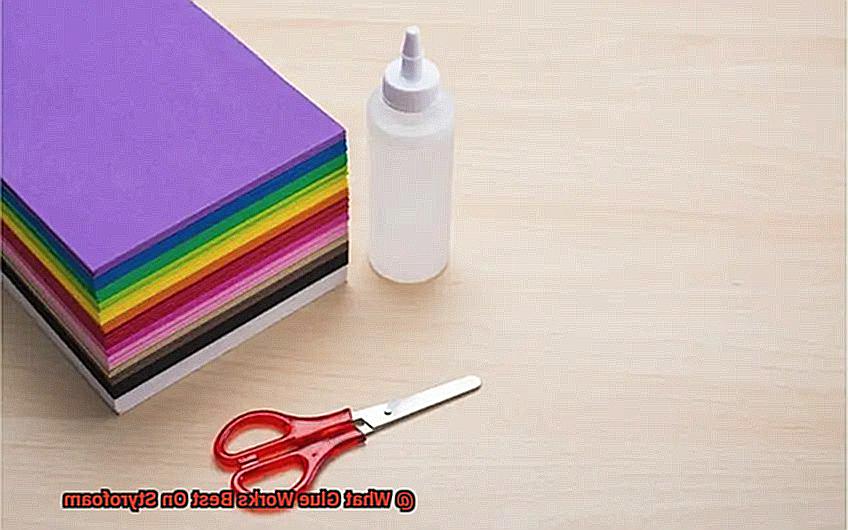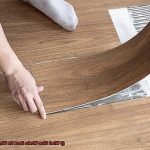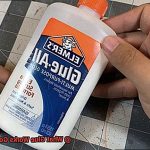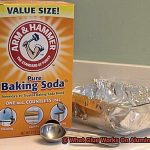Are you a crafting enthusiast? Do you find yourself in sticky situations with Styrofoam? Well, fear no more. Today, we’re diving into the world of glues to find out which one works best on this lightweight and versatile material. Whether you’re DIY-ing, building models, or creating stunning decorations, the right glue can make all the difference.
Styrofoam, also called expanded polystyrene foam, is popular for its insulation and easy shaping. But finding an adhesive that bonds it securely can be a challenge. Using the wrong glue can lead to weak connections, ugly residue, or even damage to your beloved creations.
So, which glue should you use with Styrofoam? In this blog post, we’ll explore different adhesive options and their compatibility with Styrofoam. We’ll consider factors like strength, drying time, and ease of use. Whether you’re a beginner or an expert crafter, our goal is to give you the knowledge you need for flawless projects.
Get ready to discover the glue that will take your Styrofoam creations to new heights. Let’s dive in.
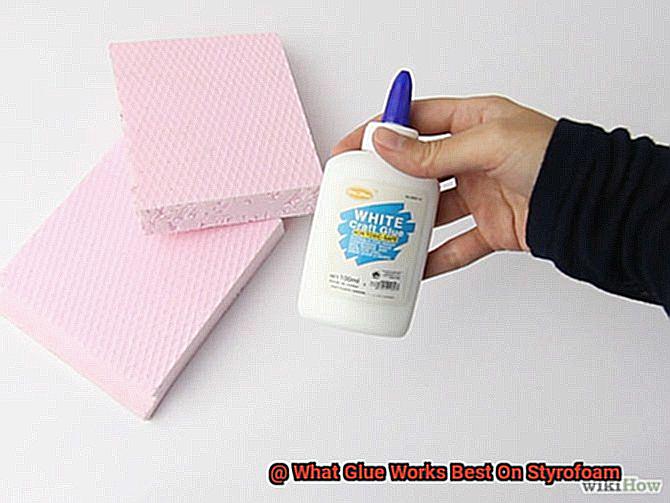
What is Styrofoam and Why Use Glue on It?
Contents
- 1 What is Styrofoam and Why Use Glue on It?
- 2 What Type of Glue Works Best on Styrofoam?
- 3 Craft Glue for Foam Materials
- 4 Hot Glue Gun with Low-Temperature Sticks
- 5 Epoxy Adhesives for Bonding Styrofoam
- 6 General-Purpose Glues for Styrofoam
- 7 Applying the Glue to Styrofoam Properly
- 8 Drying and Curing Time
- 9 Cleaning Up Accidental Spills
- 10 Conclusion
Styrofoam, a lightweight and versatile material made from expanded polystyrene (EPS), finds its usefulness in various applications such as insulation, packaging, and crafting. When it comes to working with Styrofoam, using glue is essential for joining different pieces together or attaching other materials to it.
Using glue on Styrofoam allows for the creation of larger structures or intricate designs by securely bonding multiple pieces. It provides a convenient and effective way to adhere different pieces of Styrofoam without causing any damage to the material. Moreover, glue is useful for attaching figurines or decorations onto a Styrofoam base when crafting dioramas or models.
Glue can also be employed to add texture or finish to the surface of Styrofoam. By applying a layer of glue and coating it with sand, paint, or other materials, intriguing textures and effects can be achieved. This technique proves particularly valuable when crafting decorative pieces.
However, not all glues are suitable for use on Styrofoam due to its plastic foam composition. Certain glues can cause melting or dissolving of the material. Therefore, it is crucial to select the appropriate glue that is compatible with Styrofoam to ensure a strong and durable bond.
Craft glues specifically designed for foam materials, which are typically water-based and non-toxic, are considered some of the best options for bonding Styrofoam. Low-temperature hot glue guns with suitable glue sticks can also be used if the temperature is adjusted to prevent melting or warping of the Styrofoam. Epoxy glues formulated for bonding Styrofoam are also effective choices. General-purpose glues like white craft glue or super glue may work as well but should be tested on a small area beforehand.
What Type of Glue Works Best on Styrofoam?
Styrofoam, also known as expanded polystyrene foam, is a lightweight and versatile material used in various applications. However, when it comes to bonding Styrofoam together or attaching other materials to it, choosing the right glue is crucial. Not all glues are compatible with Styrofoam, as some may dissolve or damage the foam. Here are some types of glues that work best on Styrofoam:
- Foam-safe or foam-friendly glue: These specialized adhesives are specifically formulated to bond with Styrofoam without causing any damage. They have a low solvent content, preventing them from melting or dissolving the foam. Foam-safe glues come in various forms such as liquid, spray, or glue sticks, providing options for different project requirements.
- White craft glue or PVA glue: This type of glue is readily available and affordable. It dries clear and creates a strong bond with Styrofoam. However, not all white craft glues are suitable for Styrofoam, so it’s important to check the label and ensure it specifically mentions compatibility with foam materials.
- Cyanoacrylate glue (super glue or Krazy Glue): This glue can also be used to bond Styrofoam. However, it must be used sparingly as excessive amounts can dissolve or melt the foam. It’s best to use a small amount and apply it carefully.
- Epoxy glue: Some epoxy glues are specifically formulated for bonding Styrofoam and can provide a strong and durable bond. These glues tend to be more expensive and may require specific application techniques.
It’s important to note that hot glue guns should be avoided when working with Styrofoam, as the high temperature of the glue can melt or deform the foam. If hot glue is necessary, using a low-temperature glue gun and applying the glue sparingly can help prevent damage.
Before applying any glue to Styrofoam, it’s always advisable to test it on a small and inconspicuous area first. This will help ensure compatibility and prevent any potential damage to the foam.
Craft Glue for Foam Materials
Craft glue for foam materials is a specialized adhesive designed to bond foam surfaces securely. There are several types of glue suitable for foam projects, each with its own advantages and applications.
Foam adhesives are specifically formulated to provide a strong and durable bond for foam materials. They come in various forms, including liquid glues, sprays, and glue sticks. Liquid glues are perfect for precise and controlled application on small craft projects. Sprays are convenient for covering larger areas quickly, making them ideal for larger foam projects. Glue sticks offer a mess-free solution for bonding smaller pieces of foam together.
Hot glue is another popular choice for bonding foam materials. It provides a quick bonding solution and offers a strong hold. However, it is important to use a low-temperature glue gun when working with foam to prevent melting or deformation of the material.
Fabric glue is also suitable for bonding foam materials. Designed to adhere to various types of fabrics, fabric glues can work well on foam surfaces too. They are typically water-based and dry clear, making them perfect for projects where aesthetics matter. Fabric glues provide a flexible and durable bond that can withstand bending and stretching.
When selecting a craft glue for foam materials, consider factors such as the type of foam, the size of the project, and the desired bond strength. It is always advisable to test the glue on a small, inconspicuous area of the foam before applying it to the entire project to ensure compatibility and desired results.
Hot Glue Gun with Low-Temperature Sticks
Crafting with foam materials can be a sticky situation, but fear not. There are glues specifically designed to bond those spongy surfaces securely, like a trusty superhero cape. With various options such as liquid glues, sprays, glue sticks, and even hot glue, you’ll find the perfect adhesive sidekick for your foam projects. Just remember to choose wisely based on factors like foam type and project size to ensure a strong and durable bond that will make your creations stand tall, like a skyscraper in the craft world. And don’t forget to test the glue on a small area first to avoid any unwanted surprises – after all, even superheroes have their kryptonite.
When it comes to working with Styrofoam, using a hot glue gun with low-temperature sticks can save the day. Here’s why:
- Safety: Low-temperature hot glue guns operate at a lower temperature compared to regular hot glue guns, reducing the risk of melting or damaging the Styrofoam. This ensures your foam projects remain intact and free from unsightly deformations.
- Compatibility: Low-temperature hot glue sticks are specially formulated with a lower melting point, making them ideal for bonding sensitive materials like Styrofoam. The lower temperature ensures that the glue remains pliable enough to stick without compromising the foam’s structural integrity.
- Versatility: While the bond strength may not be as strong as high-temperature hot glue guns, low-temperature hot glue guns are still suitable for most craft and lightweight projects involving Styrofoam. Whether you’re creating decorations, models, or costumes, low-temperature hot glue sticks provide a reliable adhesive option.
- Ease of Use: Low-temperature hot glue guns are user-friendly and easy to handle. The lower temperature means less risk of burns or accidental contact with hot glue, making them safer for crafters of all skill levels.
- Availability: Low-temperature hot glue guns and sticks are widely available in craft stores and online. Look for reputable brands that specifically mention compatibility with Styrofoam on the packaging to ensure you’re using the right tool for the job.
Epoxy Adhesives for Bonding Styrofoam

Epoxy adhesives offer an exceptional solution for bonding Styrofoam with their remarkable bonding capabilities and versatility. Composed of two components – a resin and a hardener – these adhesives create a chemical reaction upon mixing, leading to a solid bond.
One of the standout advantages of using epoxy adhesives for Styrofoam is their ability to provide a durable and long-lasting bond. This quality is especially crucial when working with Styrofoam, a lightweight material prone to damage. With epoxy adhesives, you can ensure that your Styrofoam projects remain intact for an extended period.
Moreover, epoxy adhesives possess excellent gap-filling properties, enabling them to fill irregularities or gaps in the Styrofoam surface. This feature proves particularly useful when working with foam materials that may have uneven surfaces. Through this capability, epoxy adhesives guarantee a strong and seamless bond.
When selecting an epoxy adhesive for Styrofoam, it is essential to choose a formula specifically designed for lightweight materials. Look for labels such as “lightweight” or “low-density” epoxy adhesives, as they will provide optimal bonding strength while preventing potential damage to your Styrofoam projects.
To ensure the best results and a strong bond, it is crucial to follow the manufacturer’s instructions when using epoxy adhesives on Styrofoam. This includes properly mixing the components, applying the adhesive to both surfaces, and allowing sufficient curing time before handling or putting stress on the bonded pieces.
While epoxy adhesives generally offer strong bonds, there may be instances where more flexibility is required in the bonded pieces. In such cases, consider using alternative adhesives like hot glue guns or foam glue, which allow for movement or flexibility in the bonded materials.
When working with epoxy adhesives on Styrofoam, proper ventilation is essential due to potential fume release during the curing process. Ensure a well-ventilated work area or wear a respirator to minimize any health risks associated with fumes.
Finally, it is always recommended to test the adhesive on a small, inconspicuous area of the Styrofoam before applying it to the entire surface. This step allows you to verify compatibility and assess the strength of the bond before committing to the adhesive for your project.
General-Purpose Glues for Styrofoam
When it comes to bonding Styrofoam, there are several types of general-purpose glues that can get the job done. Let’s dive into the different options available.
White craft glue (PVA glue) is a popular choice for Styrofoam projects. It is water-based and dries clear, making it suitable for various craft projects involving Styrofoam. PVA glue has a strong bond and is non-toxic, making it safe for use with Styrofoam. Plus, it is readily available and affordable.
Epoxy adhesive is known for its exceptional strength and durability. It forms a strong bond that can withstand high temperatures and moisture, making it ideal for heavy-duty or outdoor applications involving Styrofoam. However, it is important to ensure proper ventilation when using epoxy adhesive, as the fumes can be harmful. Following the manufacturer’s instructions is crucial for best results.
Hot glue guns are another popular choice for bonding Styrofoam. The hot glue melts the Styrofoam slightly, creating a strong bond when it cools down. Hot glue guns are easy to use and provide instant adhesion, perfect for quick craft projects or repairs involving Styrofoam. However, it’s important to test a small area first, as high temperatures can melt or deform the Styrofoam.
There are also specialized adhesives available specifically designed for bonding Styrofoam. These adhesives often come in spray form and provide a strong bond without damaging the structure of the Styrofoam.
When using any glue on Styrofoam, there are some key tips for success. First, apply a thin, even layer of glue to both surfaces and press them together firmly. This maximizes the bond strength and minimizes the risk of adhesive seeping through the Styrofoam. Additionally, allow sufficient drying or curing time as specified by the manufacturer. Rushing the process can result in a weak bond or adhesive failure.
Applying the Glue to Styrofoam Properly
To properly apply glue to Styrofoam, follow these key steps:
- Choose the right glue: Select a solvent-based adhesive specifically designed for foam materials. Avoid glues that can dissolve or damage Styrofoam.
- Prepare the surface: Lightly sand the area where the glue will be applied to create a rough texture for better adhesion. Remove any dust or debris from the surface.
- Apply a thin layer of glue: Use a brush or applicator to apply a thin and even layer of glue to both surfaces. Avoid using too much glue, as it can dissolve or deform the Styrofoam.
- Press the surfaces together: Carefully bring the surfaces together and apply even pressure across the entire surface to ensure a strong bond. Use your hands or a clamp to hold the surfaces together while the glue dries.
- Allow sufficient drying time: Follow the manufacturer’s instructions for drying time, as it may vary depending on the adhesive used. Avoid moving or disturbing the glued pieces during this period to prevent weakening of the bond.
- Consider additional reinforcement: For added strength, insert toothpicks or small wooden dowels into both surfaces before applying the glue. These reinforcements provide extra stability and prevent potential separation.
It’s important to note that different types of glues, such as hot glue or epoxy, may require different application methods. Hot glue should be applied using a glue gun and allowed to cool before joining the surfaces, while epoxy may involve mixing two components before application.
Drying and Curing Time
Drying and curing time are crucial factors to consider when it comes to gluing Styrofoam. This lightweight and porous material can easily absorb excess moisture from the glue if the drying time is too long, leading to damage or warping. To avoid these issues, it’s important to choose a glue with a fast drying time.
One popular option for Styrofoam is white craft glue (PVA glue). It dries quickly, usually within 15-30 minutes, and forms a strong bond. Plus, it dries clear, ensuring a clean finish for your project.
Hot glue is another commonly used adhesive for Styrofoam. It dries within a few minutes and provides a secure hold. However, keep in mind that hot glue can become brittle over time and may not be suitable for long-term or outdoor applications.
For more heavy-duty projects or maximum strength, epoxy adhesives are recommended. These glues consist of two components that need to be mixed together before application. While they have a longer drying and curing time, typically ranging from several hours to overnight, they offer exceptional bonding strength and durability once fully cured.
To ensure a strong and reliable bond, it’s important to follow the manufacturer’s instructions regarding drying and curing time. Factors like temperature, humidity, and the thickness of the glue layer can affect the process. Allow ample time for the glued Styrofoam to fully cure before subjecting it to any stress or load.
Cleaning Up Accidental Spills
Cleaning up accidental spills on Styrofoam can be a delicate process, as the material is sensitive to certain chemicals and solvents. To avoid damaging or melting the Styrofoam, it is crucial to approach the cleanup with care and follow the appropriate methods. Here are some tips and techniques to ensure successful cleanup.
- Act quickly: Time is of the essence when dealing with spills on Styrofoam. The longer the adhesive sits, the more difficult it will be to remove. Immediately blot the spill with a clean cloth or paper towel, gently soaking up as much of the glue as possible. Avoid rubbing or scrubbing, as this can push the adhesive deeper into the material.
- Assess the glue type: Different glues require different cleaning methods. For water-based glues like white glue or school glue, a mixture of warm soapy water can often do the trick. Prepare a solution of mild dish soap and warm water, and gently dab at the spill with a sponge or cloth soaked in the solution. Be cautious not to oversaturate the Styrofoam, as excessive moisture can dissolve or distort it.
- Specialized cleaning methods: Stronger adhesives such as super glue or epoxy may require more specific approaches. Acetone or nail polish remover can be effective in removing these types of glues from Styrofoam. Use these substances sparingly and with caution, as they can dissolve or damage the material if used excessively. Apply a small amount of acetone to a cotton swab or soft cloth and gently dab at the spill, being careful not to spread it further.
- Stubborn spills: In some cases, more stubborn spills may necessitate additional techniques. Gently sanding away dried glue residue with fine-grit sandpaper can be an option, but proceed cautiously to avoid damaging the Styrofoam. Alternatively, there are solvents specifically designed for removing adhesive residues that can be found at hardware stores or online. Always follow the manufacturer’s instructions when using these products.
- Thorough rinsing and drying: After successfully removing the glue, thoroughly rinse the area with clean water to ensure no residue or cleaning agents remain on the surface. Allow the Styrofoam to dry completely before using or storing it, preventing any potential reactions with future glues or adhesives.
1T434GttPHQ” >
Conclusion
When it comes to finding the perfect adhesive for Styrofoam, there are a few options that stand out. One of the top contenders is a glue called styrene-based adhesive. This particular glue is specifically designed to bond with Styrofoam, creating a strong and durable hold. Another fantastic option is hot glue, which works wonders on Styrofoam due to its ability to melt and fuse the material together. Additionally, you can also consider using epoxy or polyurethane adhesives, both of which have been known to work effectively on Styrofoam surfaces.
Now, let’s talk about why these glues are so great for Styrofoam. Styrene-based adhesive is formulated with ingredients that allow it to penetrate the porous surface of the foam, creating a chemical reaction that results in a solid bond. This type of glue also dries clear, ensuring that your project maintains its clean and professional appearance.
Hot glue, on the other hand, offers instant bonding power. As soon as it’s applied to the Styrofoam surface, it quickly melts and adheres to create a secure connection. Its fast-drying nature makes it ideal for quick projects or when time is of the essence.
Epoxy and polyurethane adhesives provide exceptional strength and durability. These glues create a strong chemical bond with the Styrofoam surface, ensuring that your project stays intact even under stress or pressure.
In conclusion, when deciding on the best glue for your Styrofoam project, consider styrene-based adhesive for its specialized formula and clear finish. Hot glue is an excellent choice if you need instant results or want to ensure a fast-drying process. And if strength and durability are your top priorities, epoxy or polyurethane adhesives won’t disappoint.
Remember to always follow safety guidelines when working with any adhesive and test it on a small area of your Styrofoam before committing to a full application.

